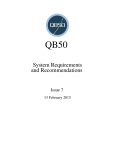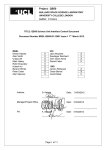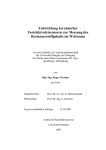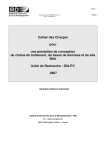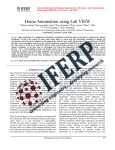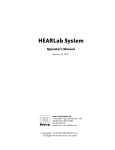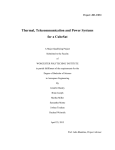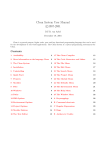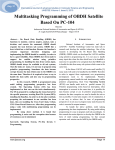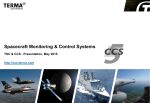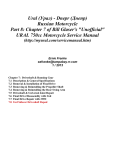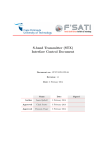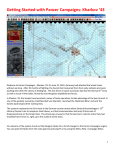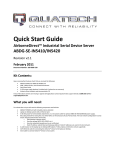Download System Requirements and Recommendations
Transcript
QB50
System Requirements
and Recommendations
Issue 4
5 July 2013
Issue No.
Issue Date
1
19 March 2012
2
24 August 2012
3
5 February 2013
4
5 July 2013
Issue 4 prepared by: Fiona Singarayar with contributions from R. Reinhard, C. Asma, J. Thoemel,
T. Scholz, C. Bernal, W. Weggelaar, G.Shirville, D. Kataria, M. Richard
Checked by
Jeroen Rotteveel
Cesar Bernal
Alan Smith
Dhiren Kataria
Ruedeger Reinhard
Fiona Singarayar
Function
CEO, ISIS
Mechanical Lead of QB50 Deployment System, ISIS
Director, MSSL
Lead of QB50 Science Payload, MSSL
QB50 Principal Investigator, VKI
QB50 Systems Engineer, VKI
Date
13 June 2013
13 June 2013
13 June 2013
13 June 2013
13 June 2013
13 June 2013
Approved by
Jan Thoemel
Cem O. Asma
QB50 Project Manager, VKI
QB50 Coordination and Control Manager, VKI
5 July 2013
5 July 2013
Issue 4
1
5 July 2013
Contents
List of acronyms
3
Applicable documents
5
Reference documents
7
1
CubeSat System Requirements
8
1.1
Structural Subsystem . . . . . . . . . . . . . . . . . . . . . . . . . . . . . . . . .
8
1.2
Attitude Determination and Control Subsystem (ADCS) . . . . . . . . . . . . . . 13
1.3
Electrical Power System (EPS) . . . . . . . . . . . . . . . . . . . . . . . . . . . . 14
1.4
On-Board Computer (OBC) and On-Board Data Handling (OBDH) . . . . . . . . 14
1.5
Telemetry, Tracking & Command . . . . . . . . . . . . . . . . . . . . . . . . . . 17
1.6
Thermal Control . . . . . . . . . . . . . . . . . . . . . . . . . . . . . . . . . . . . 19
1.7
General . . . . . . . . . . . . . . . . . . . . . . . . . . . . . . . . . . . . . . . . 19
2
Qualification and Acceptance Testing Requirements for Launch
23
2.1
Acceleration (Quasi-static) . . . . . . . . . . . . . . . . . . . . . . . . . . . . . . 23
2.2
Resonance Survey . . . . . . . . . . . . . . . . . . . . . . . . . . . . . . . . . . . 24
2.3
Sinusoidal Vibration . . . . . . . . . . . . . . . . . . . . . . . . . . . . . . . . . 25
2.4
Random Vibration . . . . . . . . . . . . . . . . . . . . . . . . . . . . . . . . . . . 25
2.5
Shock Loads . . . . . . . . . . . . . . . . . . . . . . . . . . . . . . . . . . . . . . 25
2.6
Thermal Cycling . . . . . . . . . . . . . . . . . . . . . . . . . . . . . . . . . . . 27
2.7
Thermal Vacuum . . . . . . . . . . . . . . . . . . . . . . . . . . . . . . . . . . . 27
2.8
EMC / ESD . . . . . . . . . . . . . . . . . . . . . . . . . . . . . . . . . . . . . . 27
Issue 4
2
5 July 2013
List of acronyms
1U, 2U, 3U
ABF
ACRR
BPSK
BRF
CalPoly
CDR
CVCM
DPAC
EGSE
EMC
EQM
ESD
FIPEX
FM
IARU
ICD
INMS
ISIS
LRF
LV
MDC
MNLP
MSSL
OBC
OBDH
OBSW
NPU
PCB
PDR
QPSK
RBF
RF
SCS
Issue 4
1-Unit, 2-Unit and 3-Unit CubeSat sizes, respectively
Apply Before Flight
Adjacent Channel Rejection Ratio
Binary Phase Shift Keying
Body Reference Frame
California Polytechnical State University, SLO
Critical Design Review
Collected Volatile Condensable Material
QB50 Data Processing and Archiving Centre
Electronic Ground Support Equipment
Electro-Magnetic Compatibility
Engineering / Qualification Model
Electro-Static Discharge
Flux--Probe Experiment
Flight Model
International Amateur Radio Union
Interface Control Document
Ion/ Neutral Mass Spectrometer
Innovative Solutions In Space BV
Launcher Reference Frame
Launch Vehicle
Mission Display Centre
Multi-Needle Langmuir Probe
Mullard Space Science Laboratory
On-Board Computer
On-Board Data Handling
On-Board Software
Northwestern Polytechnical University, China
Printed Circuit Board
Preliminary Design Review
Quadrature Phase Shift Keying
Remove Before Flight
Radio Frequency
Satellite Control Software
3
5 July 2013
SLO
TBC
TBD
TT&C
TML
UHF
VHF
VKI
Issue 4
San Luis Obispo, California, United States of America
To Be Confirmed
To Be Determined
Telemetry, Tracking and Command
Total Mass Loss
Ultra High Frequency
Very High Frequency
von Karman Institute for Fluid Dynamics
4
5 July 2013
Applicable documents
Reference No.
[A01]
Document Name
QB50-INMS-MSSL-ID12001 INMS Interface
Control Document Issue 4.pdf
Document Title
QB50 INMS Science Unit Interface Control Document, Mullard
Space Science Laboratory (MSSL),
11 June 2013
[A02]
INMS Compliancy Matrix.xlsx
QB50 INMS Compliancy Matrix,
Mullard Space Science Laboratory
(MSSL), 14 June 2013
[A03]
ILR-RFS FPXQB50 ICD-100001 Interface Control Document.pdf
QB50 FIPEX Science Unit Interface Control Document, Technische
Universitat Dresden (TU Dresden),
19 June 2013
[A04]
FIPEX Compliancy Matrix.xlsx
QB50 FIPEX Compliancy Matrix, Technische Universitat Dresden (TU Dresden), 19 June 2013
[A05]
QB50-UiO-ID-0001 Issue 2 Rev QB50 MNLP Science Unit InterDRAFT C.pdf
face Control Document, University
of Oslo (UiO), 11 June 2013
[A06]
MNLP Compliancy Matrix.xlsx
[A07]
ISIS.QB50.StackPack.ICD
v1.6 StackPack Interface Specifications
StackPack Interface Specifica- v1.6, Innovative Solutions in Space
tion.pdf
(ISIS), Delft, Netherlands, 25 April
2013
QB50 MNLP Compliancy Matrix,
University of Oslo (UiO), 14 June
2013
NOTE:
In addition to this QB50 System Requirements and Recommendation - Issue 4 document, CubeSats
that carry the QB50 Science Unit have to adhere to their corresponding Interface Control Document
(ICD) and their Compliancy Matrix, which are listed in this (Applicable documents) section. That
is,
• CubeSats with an INMS shall also comply with [A01] - QB50 INMS Science Unit Interface
Control Document and [A02] - QB50 INMS Compliancy Matrix
Issue 4
5
5 July 2013
• CubeSats with a FIPEX shall also comply with [A03] - QB50 FIPEX Science Unit Interface
Control Document and [A04] - QB50 FIPEX Compliancy Matrix
• CubeSats with a MNLP shall also comply with [A05] - QB50 MNLP Science Unit Interface
Control Document and [A06] - QB50 MNLP Compliancy Matrix
Issue 4
6
5 July 2013
Reference documents
Reference No.
[R01]
Document Name
call proposals QB50.pdf
Document Title
Call for CubeSat Proposals for
QB50, von Karman Institute for
Fluid Dynamics (VKI), Brussels,
Belgium, 15 February 2012
[R02]
cds rev12.pdf
CubeSat Design Specification Rev.
12, The CubeSat Program, Cal Poly
SLO, 2009
[R03]
2 4 scholz.pdf
Recommended Set of Models and
Input Parameters for the Simulations of Orbital Dynamics of
the QB50 CubeSats T. Scholz,
C.O.Asma, A.Aruliah, 15 February
2012
[R04]
ISIS.QB50.EL.001
QB50 Environment
els.pdf
Issue 4
v0.1
Lev-
7
QB50 Environmental Levels, ISIS,
1 May 2013
5 July 2013
1
CubeSat System Requirements
IMPORTANT NOTE:
Please take the following points into account:
• In addition to the requirements stated in this document, all QB50 CubeSats shall also comply with the requirements specified in CalPoly’s CubeSat Design Specification, Rev 12
[R02 ]. However, if there is any contradiction (e.g mass), then the requirement in this document supersedes it.
• Some requirements from this document, which are still valid, such as TML < 1% and CVCM
<0.1%, have been removed as they are already part of the CalPoly CubeSat Design Specification. They have been removed from this document to avoid duplication.
• VHF downlinks cannot be used.
• The orbital sunlight period is likely to be at most 65% of the orbit period and may reduce at
lower altitudes.
1.1
Structural Subsystem
Dimension
Several standard CubeSat sizes are identified in “Units” relative to the original 1-Unit CubeSat.
Only 2U and 3U CubeSats are anticipated for QB50. The dimensions are shown in Table 2.
QB50-SYS-1.1.1 CubeSats dimensions shall be as shown in Table 2.
Reference Frame
QB50-SYS-1.1.2 The CubeSats shall use the reference frame as shown in Figure 1
such that it will be in line with the reference frame of the deployment
system.
Issue 4
8
5 July 2013
Table 2: Generic CubeSat dimensions
Property
Footprint
Height
Feet
Rails
2U
100 × 100 ± 0.1 mm
227 ± 0.1 mm
8.5 × 8.5 ± 0.1 mm
External edges shall be rounded
R × 1mm or chamfered 45◦ × 1mm
3U
100 × 100 ± 0.1 mm
340.5 ± 0.1 mm
8.5 × 8.5 ± 0.1 mm
External edges shall be rounded
R × 1mm or chamfered 45◦ × 1mm
Figure 1: QB50 CubeSat reference frame
Extended Volumes
The StackPack - the deployment system for the QB50 mission - can accommodate 2U and 3U
CubeSats. It provides extra volume to accommodate deployables, appendices, booms, antennas
and solar panels. It offers lateral clearance between the CubeSat lateral sides and the StackPack
Side Panels. Moreover the StackPack provides the capability to accommodate CubeSats with both,
front and back extended volumes. However, for the CubeSats carrying the Science Unit, only the
front could be used as the back extended volume is allocated for the Science Unit.
Figure 2 shows the StackPack extended volumes provided for the QB50 CubeSats; lateral extensions (-X, +X, -Y and +Y) are depicted in green, while front one (+Z) in yellow and back one (-Z)
in blue.
Issue 4
9
5 July 2013
Figure 2: CubeSats lateral (green), front (yellow) and back (blue) extended volumes.
QB50-SYS-1.1.3 In launch configuration the CubeSat shall fit entirely within the extended volume dimensions shown in Figure 3 for a 2U CubeSat or
Figure 4 for a 3U CubeSat, including any protrusions.
Figure 3: 2U CubeSat extended volume dimensions in millimetres.
Figure 3 shows the maximum dimensions in millimetres allowed by the StackPack for the QB50
2U CubeSat extended volumes. Note that these dimensions relate to the extended volumes of the
CubeSat and not the height of the guide rails of the CubeSat. The height is still 227 mm as stated
in Table 2.
Figure 4 shows the maximum dimensions in millimetres allowed by the StackPack for the QB50
3U CubeSat extended volumes. Note that these dimensions relate to the extended volumes of the
Issue 4
10
5 July 2013
Figure 4: 3U CubeSat extended volume dimensions in millimetres.
CubeSat and not the height of the guide rails of the CubeSat. The height is still 340.5 mm as stated
in Table 2.
CubeSat Access Hatches
QB50-SYS-1.1.4 After integration into the deployer, the CubeSat shall only require
access, for any purpose, through the access hatches in the door of the
deployer. The position and dimensions of these hatches are shown in
Figure 5.
As the CubeSat can only be accessed / connected through the front door after integration into
the deployer, the access hatches on the CubeSat have to be on the front side (+Z face), which is
opposite to the Science Unit. Figure 5 defines the position of these access hatches on the CubeSat
front side (+Z face). The teams can allocate their umbilical interface / connector through any of
these two 25 mm × 13 mm areas.
Each CubeSat team is free to select the connector according to their needs as long as it complies
with the front side available areas (and of course with the CubeSat envelope). Due to the wide
range of possible solutions each team shall supply the required EGSE and harness. One (TBC)
access opportunity after integration of the CubeSat into the deployer at ISIS will be granted to
each team to perform all the required activities (data connectivity, battery charge, checkout, etc).
Afterwards only battery charging will be performed.
Mass
As stated previously, the StackPack is designed to accommodate both 2U and 3U CubeSats. Table 3 states the specifications for the maximum masses of the different QB50 CubeSat that can be
Issue 4
11
5 July 2013
Figure 5: Definition of QB50 CubeSat access hatch on the +Z face .
accommodated in the StackPack.
QB50-SYS-1.1.5 The CubeSat mass shall be no greater than that shown in Table 3.
Table 3: CubeSat masses admitted by the StackPack for QB50
CubeSat Size Maximum Mass
2U CubeSat
2.0 kg
3U CubeSat
3.0 kg
Centre of Gravity
QB50-SYS-1.1.6 The CubeSat centre of gravity shall be located within a sphere of
20 mm diameter, centred on the CubeSat geometric centre.
This is required in order to control misalignments of the StackPack centre of gravity position on
the launch vehicle.
Issue 4
12
5 July 2013
Recommendation 1:
For aerodynamic stability, it is recommended to have the CubeSat
centre of gravity towards the face of the Science Unit (-Z face, which
will be in the spacecraft ram velocity direction) with respect to the
CubeSat geometric centre.
Deployment Switches
QB50-SYS-1.1.7 Deployment switches shall be non-latching (electrically or mechanically).
Material
QB50-SYS-1.1.8 The CubeSat rails and standoffs, which contact the deployer rails,
pusher plate, door, and/or adjacent CubeSat standoffs, shall be constructed of a material that cannot cold-weld to any adjacent materials.
1.2
Attitude Determination and Control Subsystem (ADCS)
The ADCS is responsible for detumbling the satellite after deployment, pointing the satellite in
a favourable attitude to meet the mission requirements as well as for recovering it from any spin
ups during the mission. It is also responsible for determining the satellites attitude. System level
requirements that are applicable to the ADCS are the following:
QB50-SYS-1.2. 1 The CubeSat shall be able to recover from tip-off rates of up to
10◦ / sec (TBC) within 2 days.
QB50-SYS-1.2. 2 The Science Unit will be accommodated at one end of the CubeSat,
on a 10 mm × 10 mm face — the -Z face using the CubeSat reference
frame as shown in Figure 1. The vector normal to this face shall be in
the spacecraft ram velocity direction. The face shall not be available
for solar cells, or for any other subsystem and nothing must forward
this face.
Issue 4
13
5 July 2013
1.3
Electrical Power System (EPS)
The main purpose of the EPS is to provide enough electrical power to the rest of the subsystems
such that the satellite is able to function during the entire length of the mission. The following are
system level requirements that are applicable to the EPS:
QB50-SYS-1.3. 1 The CubeSat shall provide sufficient power at the appropriate voltage, either by solar array generation or battery, to meet the power
requirements of all satellite subsystems in all modes of operation.
QB50-SYS-1.3. 2 The CubeSat shall be able to be commissioned in orbit following
the last powered-down state without battery charging, inspection or
functional testing for a period of up to 8 months.
QB50-SYS-1.3. 3 The CubeSat shall be powered OFF during the entire launch and
until it is deployed from the deployment system.
1.4
On-Board Computer (OBC) and On-Board Data Handling (OBDH)
As the ‘brain’ of the satellite, the OBC/OBDH subsystem is responsible for communicating with
the rest of the subsystems and for relaying information between them. The following are system
level requirements that are applicable to the OBC/OBDH subsystem:
Whole Orbit Data (WOD)
QB50-SYS-1.4. 1 The CubeSat shall collect whole orbit data and log telemetry every
minute.
QB50-SYS-1.4. 2 The whole orbit data shall be stored in the OBC until they are downloaded before they are overwritten.
This is so that the information could be used to determine the causes of any problems in the case
of a CubeSat anomaly.
“Whole orbit data” or WOD is housekeeping data that is collected during the whole orbit. It
Issue 4
14
5 July 2013
includes CubeSat attitude and position as well as a housekeeping data set chosen by the CubeSat
teams consisting of parameters such as the spacecraft battery temperature, battery current, battery
voltage, OBC voltage / current, solar panel temperatures etc.
Clock
QB50-SYS-1.4. 3 Any computer clock used on the CubeSat and on the ground segment
shall exclusively use Coordinated Universal Time (UTC) as time reference.
QB50-SYS-1.4. 4 The OBC shall have a real time clock information with an accuracy
of 500ms (TBC) during science operation. Relative times should be
counted / stored according to the epoch 01.01.2000 00:00:00 UTC.
This requirement requests real time clock information and not necessarily a real time clock on
board the CubeSat. The use of a GPS or an uplink clock synchronization command could provide
such information.
Inhibit Override
QB50-SYS-1.4. 5 The onboard software (OBSW) and mission support software shall
not be allowed to override hardware inhibits such as the deployment
switch. (This is not applicable during check-out via umbilical cord).
Deadlock Prevention
QB50-SYS-1.4. 6 The OBSW and mission support software shall protect itself against
infinite loops, computational errors and possible lock ups.
Defensive Programming
QB50-SYS-1.4. 7 The check of incoming commands, data and messages, consistency
checks and rejection of illegal input shall be foreseen for the OBSW
and mission support software.
Issue 4
15
5 July 2013
OBSW Code
QB50-SYS-1.4. 8 The OBSW shall only contain code that is intended to be used in
orbit.
Satellite Control Software
The Satellite Control Software (SCS) is a software package provided by the QB50 Project that
could be implemented by the CubeSat teams on their own ground stations. Each team can have
access to the SCS package for use in ground stations under a bilateral license agreement. The SCS
will provide:
•
•
•
•
•
Ground station interface software
TM/TC Front End
CubeSat Control System
Operations User Interfaces software
Communications handling with the Data Processing and Archiving Centre (DPAC) and Mission Control Centre (MCC)
It is not a requirement to use the SCS, and teams may propose an alternative solution provided it
meets the requirements for controlling the satellite and communicating with the DPAC and MCC.
If utilized, the SCS will allow the CubeSat teams to assist each other with any difficulties with the
common interface and will provide the CubeSat teams with a lighter software development. This
will contribute to the overall project success by offloading some ground tasks that teams might not
have expertise in.
Another advantage is that the teams will benefit from compatibility with other teams and could
collaborate on their on-board software implementations. This option also facilitates the possibility
of using other teams ground stations. The software provided is extremely flexible and individual
teams can integrate their own specifics at many levels, for instance integrating their own payloadspecific data processing or visualization.
For the teams who chose to use the QB50 SCS, the packet and frame protocol is defined and the
teams will need to comply with it.
Issue 4
16
5 July 2013
1.5
Telemetry, Tracking & Command
Downlink
QB50-SYS-1.5. 1 VHF shall not be used for downlink.
QB50-SYS-1.5. 2 If UHF is used for downlink, the CubeSat shall use a downlink data
rate of at least 9.6 kbps.
QB50-SYS-1.5. 3 If UHF is used for downlink, the transmission shall fit in 20 kHz at
-30 dBc, measured without Doppler, but over the entire operating
temperature range.
This will help ensure that each satellite can be quickly identified even at the start of the mission
when many or all of the spacecraft may be overhead a single ground station.
QB50-SYS-1.5. 4 All CubeSats shall have and make use of a national amateur radio
call sign in the telemetry downstream.
Recommendation 2:
It is recommended to implement BPSK or QPSK downlinks because
of their spectral efficiency.
Recommendation 3:
It is recommended to use different bands for uplink and downlink.
Uplink
QB50-SYS-1.5. 5 If VHF is used for uplink, it shall have a data rate no greater than
1.2 kbps.
QB50-SYS-1.5. 6 If UHF is used for uplink, it shall have a data rate no greater than
9.6 kbps.
QB50-SYS-1.5. 7 All CubeSats shall have the capability to receive a transmitter shutdown command at all times after the CubeSat’s deployment switches
have been activated from deployer ejection.
Issue 4
17
5 July 2013
QB50-SYS-1.5. 8 Once a transmitter shutdown command is received and executed by
the CubeSat, a positive command from the ground shall be required
to re-enable the transmitter. Power reset (e.g. following eclipse)
should not re-enable the transmitter.
QB50-SYS-1.5. 9 The CubeSat provider shall have access to a ground station which
has the capability and permission to send telecommands through an
uplink to control its satellite and to upload and execute timed Instrument Command Files. The format of these commands is TBD.
QB50-SYS-1.5. 10 The CubeSat shall determine its position to within 1 km accuracy.
This requirement is to help with the identification and tracking of the CubeSats when it is first
launched as they will be in a big cloud. It is also for consistency among all the QB50 CubeSats.
This requirement supersedes any position accuracy requirement of the Science Units.
QB50-SYS-1.5. 11 The CubeSat shall transmit its position, time and its radio call sign
through a beacon at least once every 30 seconds or more often if the
power budget permits.
QB50-SYS-1.5. 12 If UHF is used for uplink, the radio receiver shall have an Adjacent
Channel Rejection Ratio (ACRR) of at least 100 dB.
This is to avoid possible blocking of the receiver or interference from nearby QB50 satellites.
Teams should also be aware that such operation will require very quick ( < 2ms) changeover time
between transmit and receive when working with short frames.
Downlink / Uplink Framing Protocol
QB50-SYS-1.5. 13 The CubeSat shall use the AX.25 Protocol (UI Frames).
Since the identifier describing the source and the destination in the address field of the frames shall
be unique for each CubeSat and its ground station within QB50, the satellite call sign for each
CubeSat can be assigned by the QB50 Project to the CubeSat teams after the frequency allocation
and coordination process. The radio call sign for the operating ground station will have to be
Issue 4
18
5 July 2013
obtained locally by each team.
QB50-SYS-1.5. 14 User-friendly and documented software consisting of a) CubeSat
data Frames Decoder b) CubeSat data Packet Decoder and c) CubeSat data Viewer that complies with radio amateur regulations shall
be made available to VKI 6 months before the nominal launch date.
The data viewer can be skipped, if a documented spreadsheet/csv (incl. column header information) file will be generated by the decoder software, so the data can be viewed with external
software e.g. Excel.
1.6
Thermal Control
QB50-SYS-1.6.1 The CubeSat shall maintain all its electronic components within its
operating temperature range while in operation and within survival
temperature range at all other times after deployment.
The operational and survival temperature range for components will vary between teams based on
hardware specification.
QB50-SYS-1.6.2 The CubeSat shall survive within the temperature range of −10◦ C
(TBC) to +50◦ C (TBC) from the time of launch until its deployment
from the deployment system.
1.7
General
Lifetime
QB50-SYS-1.7.1 The CubeSat shall be designed to have an in-orbit lifetime of at least
3 months.
Issue 4
19
5 July 2013
Material Degradation
QB50-SYS-1.7.2 The CubeSat shall not use any material that has the potential to
degrade in an ambient environment during storage after assembly,
which could be as long as approximately 2 years.
Conformal Coating
Recommendation 4:
All electronic assemblies and electronic circuit boards should be conformally coated.
Conformal coating is a standard low-cost protection process for printed circuit boards (PCBs). It
provides electrical insulation, protection against harsh elements such as solvents, moisture, contamination, dust or debris that could damage the electronic component.
Environmental
QB50-SYS-1.7.3 The CubeSat shall withstand a total contamination of 3.1 mg/m2
(TBC before CDR) at all phases of the launch vehicle ground operation and in flight.
QB50-SYS-1.7.4 The CubeSat shall withstand a maximum pressure drop rate of
3.92 kPa/sec (TBC before CDR).
Cleanliness, Handling, Storage and Shipment
The whole set of QB50 CubeSats will undergo checkout and integration into the StackPack at ISO
Class 8 clean room ISIS facility.
QB50-SYS-1.7.5 If a CubeSat has any special requirement in terms of cleanliness,
handling, storage or shipment, these shall be communicated to the
deployer integrator (ISIS BV) and also be approved by ISIS, 12
months before delivery of the CubeSat and also highlighted in the
User Manual.
The requirement(s) shall be well justified and explained in the proposal in order to be studied and
possibly taken into account. The acceptance of any special requirement is not granted in advance.
Issue 4
20
5 July 2013
Recommendation 5:
The CubeSats should have a dedicated case for transport and storage.
Apply Before Flight, Remove Before Flight items
QB50-SYS-1.7.6 Apply Before Flight (ABF) items, including tags and/or labels, shall
not protrude past the dimensional limits of the CubeSat extended
volumes (as defined in Figure 3 and Figure 4) when fully inserted.
QB50-SYS-1.7.7 All Remove Before Flight (RBF) items shall be identified by a bright
red label of at least four square centimetres in area containing the
words “REMOVE BEFORE FLIGHT” or “REMOVE BEFORE
LAUNCH” and the name of the satellite printed in large white capital letters.
Naming
QB50-SYS-1.7.8 The CubeSat name shall be printed, engraved or otherwise marked
on the CubeSat and visible through the access hatch in the door of
the deployer.
Mission Display Centre (MDC)
QB50-SYS-1.7.9 The CubeSat provider shall transfer housekeeping and “quick look”
sensor data to the Mission Display Centre (MDC) within 24 hours
following reception on the ground. The format of this data, and the
composition of “quick look” sensor data, is TBD.
The QB50 MDC will perform the following functions:
1. Receive “quick look” science data from all of the CubeSat operation centres, from their
respective CubeSat(s)
2. Receive telemetry and house-keeping data from all of the CubeSat operation centres, from
their respective CubeSat(s)
3. Display which ground station is in contact with which CubeSat, where applicable
4. Pre-process “quick look” science data and telemetry and house-keeping data
5. Compare predicted with actual trajectories
Issue 4
21
5 July 2013
6. Monitor the status and health of the CubeSats and the deployment system
7. Predict and continuously updating the approximate time and latitude/ longitude of atmospheric re-entry for the CubeSats
8. Distribute data products to the science operations team, QB50 teams and the general public
(detailed data dissemination plan is TBD)
Parallel QB50 MDCs will be set up at VKI, Stanford in the USA and NPU in China.
Model Philosophy
Recommendation 6:
It is recommended for CubeSat teams to adopt the Engineering
Qualification Model - Flight Model (EQM-FM) approach in building their CubeSat.
A qualification model (QM) is a prototype which is will undergo qualification test. A QM could
serve as a spare part replacement and moreover could be used to troubleshoot if a complex problem
occurs. This is especially useful if the problem occurs while the FM CubeSat is not accessible such as at the launch site, or in orbit. Hardware costs are usually low compared to the overall cost.
Most launch vehicle providers prefer that the payload uses an EQM-FM approach. As such, the
levels for the qualification and acceptance testing are already available. The following chapter
provides the envelope of the qualification and acceptance testing levels as these are already known.
The ProtoFlight testing levels will mostly likely be at an intermediate level between qualification
and acceptance. However, these levels are not yet known as the ProtoFlight approach has to be
requested and agreed with the selected launch vehicle provider. Once the LV is selected, the levels
for the ProtoFlight Testing can be made available.
Issue 4
22
5 July 2013
2
Qualification and Acceptance Testing Requirements for Launch
The following launch vehicles (LVs) are being considered for QB50: Cyclone-4, Dnepr, PSLV5, Rockot and Soyuz. The final decision for the selection of the launch vehicle (LV) is pending
approval by EC/ REA.
It will most likely be a sun-synchronous circular orbit with an altitude of 350 - 400km (TBC before
CDR) ±7km, an inclination of 98.6±0.08◦ , eccentricity of ±0.04, and a local time of descending
node of TBD.
As it is not certain what the final selection will be, a launcher envelope is provided to which the
CubeSats should be designed. This chapter describes the the worst case qualification and acceptance testing requirements among the five considered launch vehicles for EQM-FM test philosophy
(Engineering/Qualification Model and Flight Model).
For qualification of the CubeSat design, an EQM of the CubeSat has to be subjected to the required
qualification tests at qualification levels and durations as defined in this chapter. For acceptance
of the CubeSat, the FM of the CubeSat has to be subjected to the required acceptance tests at
acceptance levels and durations as defined in this chapter. The mentioned values correspond to the
values required by the Launch Vehicle Provider; The CubeSat teams can multiply these values by
their own safety factor.
The orientation of the satellite reference frame {BRF} with respect to the launch vehicle reference
frame {LRF} is generally not known sufficiently ahead of time. And since this may vary from
team to team, all the CubeSats shall be subjected to the most severe level imposed by the launch
vehicle, characteristics of which are defined in the corresponding subsections, in all three mutually
perpendicular directions X, Y, Z of the satellite {BRF}.
At this stage, it is recommended for the teams to identify the facilities in which they will perform
the following tests for their CubeSat.
2.1
Acceleration (Quasi-static)
Table 4 states the characteristics of the acceleration (quasi-static) test and indicates whether or not
it is required.
Issue 4
23
5 July 2013
QB50-SYS-2.1.1 CubeSat shall pass the acceleration (quasi-static) test as per Table 4.
Table 4: Acceleration (quasi-static) test characteristics
Qualification
Required
{BRF}
X, Y, Z
12 g
Acceleration (quasi-static) test
Reference Frame
Direction
Amplitude
2.2
Acceptance
Not Required
Resonance Survey
Table 5 states the characteristics of the resonance survey test and indicates whether or not it is
required. During the test, the CubeSat shall be attached to an absolute rigid base. It is common
practice to run a resonance survey test before and after running a test at full level. By comparing
the results of the resonance survey tests, a change in CubeSat integrity due to settling or possible
damage can be found.
QB50-SYS-2.2. 1 The CubeSat shall pass a resonance survey test, the characteristics
of which are stated in Table 5 and the lowest natural frequency of
the FM of the CubeSat shall be > 90 Hz.
Table 5: Resonance survey test characteristics
Resonance survey test
Reference Frame
Direction
Type
Sweep rate
Profile
Qualification
Required
{BRF}
X, Y, Z
Harmonic
2 oct/min
Frequency, [Hz] Amplitude, [g]
5
0.15∗
100
0.15∗
Acceptance
Required
{BRF}
X, Y, Z
Harmonic
2 oct/min
Frequency, [Hz]
5
100
Amplitude, [g]
0.15∗
0.15∗
∗
Depending on the test equipment higher value could be required in order to properly identify the
natural frequencies of the CubeSat.
Issue 4
24
5 July 2013
2.3
Sinusoidal Vibration
Table 6 states the characteristics of the sinusoidal vibration test and indicates whether or not it is
required.
QB50-SYS-2.3.1 The CubeSat shall pass the sinusoidal vibration tests as per Table 6
(TBC before CDR).
Table 6: Sinusoidal vibration test characteristics
Qualification
Required
{BRF}
X, Y, Z
2 oct/min
Sine vibration test
Reference Frame
Direction
Sweep rate
Profile
2.4
Acceptance
Required
{BRF}
X, Y, Z
4 oct/min
Frequency, [Hz] Amplitude, [g]
5
1.3
8
2.5
100
2.5
Frequency, [Hz]
5
8
100
Amplitude, [g]
1
2
2
Random Vibration
Table 7 states the characteristics of the random vibration test and indicates whether or not it is
required.
QB50-SYS-2.4. 1 The CubeSat shall pass the random vibration tests as per Table 7
(TBC before CDR).
2.5
Shock Loads
Table 8 states the characteristics of the shock test and indicates whether or not it is required. The
CubeSat shall withstand, without any degraded performance, the shock levels indicated in Table 8.
The shock test is applied 2 times along each of the 3 axes.
Issue 4
25
5 July 2013
Table 7: Random vibration test characteristics
Qualification
Required
{BRF}
X, Y, Z
8.03 g
120 s
Random vibration test
Reference Frame
Direction
RMS acceleration
Duration
Profile
Acceptance
Required
{BRF}
X, Y, Z
6.5 g
60 s
Frequency, [Hz] Amplitude, [g2 /Hz] Frequency, [Hz]
20
0.009
20
130
0.046
50
800
0.046
200
2000
0.015
640
2000
Amplitude, [g2 /Hz]
0.007
0.007
0.035
0.035
0.010
QB50-SYS-2.5. 1 The CubeSat shall pass the shock tests as per Table 8 (TBC before
CDR).
Table 8: Shock test characteristics
Qualification
Acceptance
Shock test
Required
Not Required
Reference Frame
{BRF}
Direction
X, Y, Z
Q-factor
10
Number of shocks
2
Profile
Frequency, [Hz] Spectrum, [g]
Issue 4
30
5
100
100
700
1500
1000
2400
1500
4000
5000
4000
10000
2000
26
Frequency, [Hz]
Spectrum, [g]
5 July 2013
2.6
Thermal Cycling
Table 9 states the characteristics of the thermal cycling test and indicates whether or not it is
required.
QB50-SYS-2.6. 1 The CubeSat shall pass the Thermal Cycling tests as per Table 9
(TBC before CDR).
Table 9: Thermal Cycling test characteristics
Qualification Acceptance
2.7
Thermal Cycling test
Required
Required
Values
TBD
TBD
Thermal Vacuum
Table 10 states the characteristics of the thermal vacuum test and indicates whether or not it is
required.
QB50-SYS-2.7. 1 The CubeSat shall pass the Thermal Vacuum tests as per Table 10
(TBC before CDR).
Table 10: Thermal Vacuum test characteristics
Qualification Acceptance
2.8
Thermal Vacuum test
Required
Required
Values
TBD
TBD
EMC / ESD
Table 11 states the characteristics of the EMC / ESD test and indicates whether or not it is required.
QB50-SYS-2.8. 1 The CubeSat shall pass the EMC / ESD tests as per Table 11 (TBC
before CDR).
Issue 4
27
5 July 2013
Table 11: EMC / ESD characteristics
Qualification Acceptance
Issue 4
EMC / ESD test
Required
Required
Values
TBD
TBD
28
5 July 2013





























